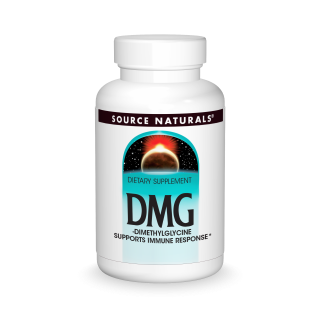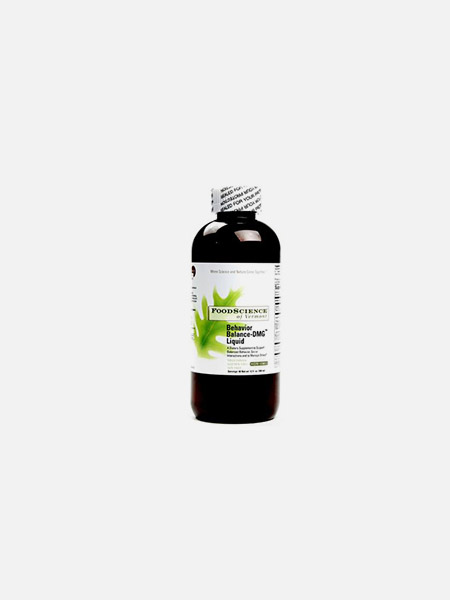N,N-Dimethylglycine (short: DMG) is an intermediate of choline metabolism. Betaine (metabolized from choline and is a metabolic precursor to dimethylglycine) donates a methyl group to homocysteine to form methionine [1]. By this removal of one methyl group from betaine, dimethylglycine is formed [1]. DMG is often sold commercially as hydrochloride salt (dimethylglycine HCL).
Drugs.com provides accurate and independent information on more than 24,000 prescription drugs, over-the-counter medicines and natural products. This material is provided for educational purposes only and is not intended for medical advice, diagnosis or treatment. DMG is responsible for triggering over 41 important biochemical reactions in the body. Choline is converted to betaine which loses a methyl group to become DMG. Transmethylation then occurs. This is an enzyme controlled reaction where a methyl group is donated by DMG to complete the synthesis of another molecule, sarcosine. DMG: An All-Natural Wellness Builder by Roger V. Dimethylglycine (DMG) is a relatively small molecule with an amazing power to change and improve health, well-being, and vitality in a person's life.
Dimethylglycine’s Effects on Athletic Performance and Bodybuilding:
Dimethylglycine has been claimed to be an athletic performance enhancer (for bodybuilding) and can be found in various sports supplements. Since dimethylglycine donates methyl groups to transmethylation process it is claimed to improved energy usage. Therefore, it is often marketed and sold as an energiser.
The interest in dimethylglycine arose from a report indicating that N,N-Dimethylglycine reduces lactic acid concentration in blood in response to surgical stress in animals [2]. Further human and animal studies yielded inconsistent results. A study on dimethylglycine-treated horses by Moffit et al. [3] reported lower plasma lactate concentrations after treadmill exercise. However, this study raised doubts about dimethylglycines effectiveness due to an unbalanced design used. Rose et al. [4] found no differences in muscle lactate concentrations in horses treated with dimethylglycine and horses receiving placebo.
In trained athletes, Pipes [5] noted a 23,6% increase in time to fatigue after DMG supplementation. In contrast, Gray and Larry [6] reported no significant changes in short-term maximal treadmill performance between the group receiving pangamic acid (calcium gluconate and N, N-Dimethylglycine) and control. No improvements in aerobic and anaerobic performance were also reported when 400 mg of DMG per/kg of body weight was administered to elite basketball players [7]. DMG also failed to improve maximal treadmill exercise to exhaustion in well-trained college women [8]. Authors of this study concluded that there is no evidence to recommend DMG as an ergogenic aid to endurance athletes.
Dimethylglycine supplementation seems to have little to no effect on athletic performance besides evidence available is limited and conflicting. More well-researched clinical trials should be done before any definitive conclusions can be made.
Other Dimethylglycine Uses
Treatment of Autism
N,N-dimethylglycine has also been reported to be beneficial in children with autism [9]. Kern et al. [9] reported that some children seem to respond positively to the dimethylglycine supplementation but overall behavioural assessments were not significantly different from children receiving placebo. Same was reported by Bolman and assistants [10], however, the weakness of this study is low dosage used in a small number of children. According to available evidence, subjects treated with DMG show little to no difference compared to untreated subjects for treatment of autism spectrum disorder [11].
Immunostimulant Properties
DMG may improve body’s immune system as reported by Graber and others [12]. Results of their study suggest that dimethylglycine supplementation improves humoral as well as cell-mediated immune responses in humans [12].
Side Effects
Very large doses up to 200 mg/kg given to animal models caused no adverse events [7]. This is not surprising as DMG is a natural metabolite which doesn’t build up in the body.
(Other common names: Pangamic Acid, Vitamin B15, Pangamate)
References
- Friesen, Russell W., et al. “Relationship of DMG, choline, and betaine with oxoproline in plasma of pregnant women and their newborn infants.” The Journal of nutrition 137.12 (2007): 2641-2646.
- Meduski, J. W., et al. 1980. “Decrease of lactic acid concentration in blood of animals given N,N-dimethylglycine.” Presented at Pacific Slope Biomedical Conference, Univ. of California, San Diego, (1980) 7-9.
- Moffitt, P., et al. “Venous lactic acid levels in exercising horses fed N, N-DMG.” Proceedings of the 9th Equine Nutrition and physiology Symposium, E., Lansing, Michigan. 1985.
- Rose, R. J., et al. “Effects of N, N-DMG on cardiorespiratory function and lactate production in thoroughbred horses performing incremental treadmill exercise.” Veterinary Record 125.10 (1989): 268-271.
- Pipes, T. V. “The effects of pangamic acid on performance in trained athletes.” Med. Sci. Sports Exercise (1980) 12:98
- Gray, Michael E., and Larry W. Titlow. “The effect of pangamic acid on maximal treadmill performance.” Medicine and science in sports and exercise 14.6 (1982): 424.
- Reza, Attarzadeh Seyed, et al. “The effect of DMG administration on Biochemical Blood Parameters in Youth elite Basketball Players.” (2013) 55-59.
- Brown, H., L. M. Reimnitz, and A. J. Koch. “No Effect of DMG on Maximal Aerobic Power.” The Journal of Strength & Conditioning Research 25 (2011): S109-S110.
- Kern, Janet K., et al. “Effectiveness of N, N-DMGin autism and pervasive developmental disorder.” Journal of Child Neurology 16.3 (2001): 169-173.
- Bolman, William M., and John A. Richmond. “A double-blind, placebo-controlled, crossover pilot trial of low dose DMGin patients with autistic disorder.” Journal of autism and developmental disorders 29.3 (1999): 191-194.
- Rossignol, Daniel A. “Novel and emerging treatments for autism spectrum disorders: a systematic review.” Ann Clin Psychiatry 21.4 (2009): 213-36.
- Graber, Charles D., et al. “Immunomodulating properties of DMGin humans.” Journal of Infectious Diseases 143.1 (1981): 101-105.
Generic Name: phenylephrine (oral) (FEN il EFF rin)
Brand Name:Nasop, Sudafed PE, Sudogest PE, ..show all 22 brand namesNeo-Synephrine, Ah-Chew D, Despec-SF, Biorphen, Lusonal, Sudafed PE Quick Dissolve, Sudafed PE Extra Strength, Triaminic Thin Strips Nasal Congestion, Triaminic Toddler Congestion Thin Strips, Nasop12, Dimetapp Cold Drops, Triaminic Thin Strips Cold, Triaminic Thin Strips Infant Decongestant, Dimetapp Children's Cold & Allergy, Phenyl-T, PediaCare Children's Decongestant, Sudafed PE Children's Nasal Decongestant, Vazculep, Sudafed PE Congestion
Dosage Forms: oral liquid (2.5 mg/5 mL); oral tablet (10 mg); oral tablet, chewable, extended release (tannate 10 mg); oral tablet, disintegrating (10 mg)
What is phenylephrine?

Phenylephrine is a decongestant that is used to treat stuffy nose and sinus congestion caused by the common cold, hay fever, or other allergies.
Dmg Hcl
Phenylephrine may also be used for purposes not listed in this medication guide.
Important Information
Do not use phenylephrine if you have used an MAO inhibitor in the past 14 days, such as isocarboxazid, linezolid, methylene blue injection, phenelzine, rasagiline, selegiline, or tranylcypromine.

Before taking this medicine
Do not use phenylephrine if you have used an MAO inhibitor in the past 14 days. A dangerous drug interaction could occur. MAO inhibitors include isocarboxazid, linezolid, methylene blue injection, phenelzine, rasagiline, selegiline, tranylcypromine, and others.
You should not use phenylephrine if you are allergic to it.
Ask a doctor or pharmacist if this medicine is safe to use if you have:
heart disease, high blood pressure;
diabetes;
a thyroid disorder;
an enlarged prostate and urination problems; or
any drug allergies.
Ask a doctor before using this medicine if you are pregnant or breast-feeding.
The liquid form of this medicine may contain phenylalanine. Check the medication label if you have phenylketonuria (PKU).
How should I take phenylephrine?
Use exactly as directed on the label, or as prescribed by your doctor. Cold medicine is only for short-term use until your symptoms clear up.
Dmg Hcl Benefits
Always follow directions on the medicine label about giving cold medicine to a child.
You must chew the chewable tablet before you swallow it.
Measure liquid medicine carefully. Use the dosing syringe provided, or use a medicine dose-measuring device (not a kitchen spoon).
Remove an orally disintegrating tablet from the package only when you are ready to take the medicine. Place the tablet in your mouth and allow it to dissolve, without chewing. Swallow several times as the tablet dissolves.
Call your doctor if your symptoms do not improve after 7 days, or if you have a fever, rash, or headaches.
If you need surgery, tell your surgeon if you are currently using phenylephrine.
Store at room temperature away from moisture and heat. Do not freeze.
What happens if I miss a dose?
Since cold medicine is used when needed, you may not be on a dosing schedule. Skip any missed dose if it's almost time for your next dose. Do not use two doses at one time.
What happens if I overdose?
Seek emergency medical attention or call the Poison Help line at 1-800-222-1222.
What should I avoid while taking phenylephrine?
Ask a doctor or pharmacist before using other cough or cold medicines that may contain similar ingredients.
Phenylephrine side effects
Get emergency medical help if you have signs of an allergic reaction:hives; difficulty breathing; swelling of your face, lips, tongue, or throat.
Stop using phenylephrine and call your doctor at once if you have:
fast, pounding, or irregular heartbeat;
severe dizziness or nervousness;
sleep problems (insomnia); or
increased blood pressure--severe headache, blurred vision, pounding in your neck or ears.
Common side effects may include:
flushing (warmth, redness, or tingly feeling);
loss of appetite; or
feeling restless or excited (especially in children).
This is not a complete list of side effects and others may occur. Call your doctor for medical advice about side effects. You may report side effects to FDA at 1-800-FDA-1088.
Phenylephrine dosing information
Usual Adult Dose for Hypotension:
Perioperative dosing (patients undergoing surgery with neuraxial or general anesthesia):
Initial dose: 50 to 250 mcg by intravenous bolus (most common doses: 50 to 100 mcg)
Maintenance dose: 0.5 to 1.4 mcg/kg/min by intravenous continuous infusion (titrate to blood pressure goal)
Septic or Other Vasodilatory Shock:
0.5 to 6 mcg/kg/min by intravenous continuous infusion (titrate to blood pressure goal)
-No bolus
-Doses over 6 mcg/kg/min do not show significant incremental blood pressure increases.
 Valle Vista Elementary is a K-5 School located in Hemet, California. One of 29 schools in Hemet USD.
Valle Vista Elementary is a K-5 School located in Hemet, California. One of 29 schools in Hemet USD.
Usual Adult Dose for Shock:
Perioperative dosing (patients undergoing surgery with neuraxial or general anesthesia):
Initial dose: 50 to 250 mcg by intravenous bolus (most common doses: 50 to 100 mcg)
Maintenance dose: 0.5 to 1.4 mcg/kg/min by intravenous continuous infusion (titrate to blood pressure goal)
Septic or Other Vasodilatory Shock:
0.5 to 6 mcg/kg/min by intravenous continuous infusion (titrate to blood pressure goal)
-No bolus
-Doses over 6 mcg/kg/min do not show significant incremental blood pressure increases.
Usual Adult Dose for Nasal Congestion:
10 mg orally every 4 hours
Maximum dose: 60 mg per 24 hours
Usual Pediatric Dose for Nasal Congestion:
12 years and older: 10 mg orally every 4 hours
Maximum dose: 60 mg per 24 hours
What other drugs will affect phenylephrine?

Many drugs can affect phenylephrine, and some drugs should not be used at the same time. Tell your doctor about all your current medicines and any medicine you start or stop using. This includes prescription and over-the-counter medicines, vitamins, and herbal products. Not all possible interactions are listed here.
Frequently asked questions

Further information
Remember, keep this and all other medicines out of the reach of children, never share your medicines with others, and use this medication only for the indication prescribed.
Always consult your healthcare provider to ensure the information displayed on this page applies to your personal circumstances.
Copyright 1996-2021 Cerner Multum, Inc. Version: 8.01.
More about phenylephrine
- During Pregnancy or Breastfeeding
Consumer resources
Other brands:Neo-Synephrine, Sudafed PE Congestion, Sudogest PE, Biorphen, .. +4 more
Comments are closed.